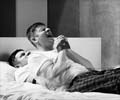Glossary
Antidepressant: a drug used to prevent or treat depression.Brain stem: The stem like part of the brain that is connected to the spinal cord. The brain stem is small but important. It consists of the pons, midbrain, and the medulla oblongata. It manages messages going between the brain and the rest of the body, and it also controls basic body functions such as breathing, swallowing, heart rate, and blood pressure. The brain stem also controls consciousness and determines whether one is awake or sleepy.
CT Scan: Computerized tomography scan .This device reads the pictures of body structures from a computer which takes the data from X-ray images and constructs pictures of them on a screen.
Dreams: A play of the minds’ thoughts and feelings during sleep.
Electrocardiogram: This is a non invasive procedure, where electrodes are positioned on the chest and connected to a device that records the electrical activity of the heart, output as a graph.
Electroencephalogram: EEG in short, it enables a picture of the electrical current in the brain. Electrodes placed on the scalp is connected to a machine that prints out the electrical impulses of the brain on a paper or a computer screen.
Neurological: Having to do with the nerves or the nervous system.
Non-REM sleep: Depicts the 4 stages of sleep, from 1 to 4 implying the distinct states of the body during sleep.
Paralysis: Paralysis implies failure of voluntary movement in the muscles or limbs. This could be partial where the loss affects one muscle or limb, called as palsy, or could manifest as a total loss of movement in all the muscles, called as total paralysis.
Parkinson disease: A gradual degenerative neurological disease where victims portray lack of expression, muscle weakness, tremors, and a slow gait. This is thought to be caused by atrophy in the basal ganglia, a specific area in the brain.Additionally inadequate levels of the neurotransmitter dopamine is thought to be behind the condition.
REM Sleep (Rapid Eye Movement Sleep): The sleep stage in which vivid dreaming occurs; identified by the occurrence of rapid eye movements under closed eyelids, motor paralysis and low voltage EEG patterns. Also associated with bursts of muscular twitching, irregular breathing, irregular heart rate, and increased autonomic activity.










